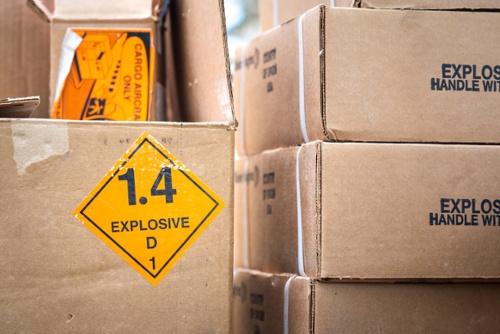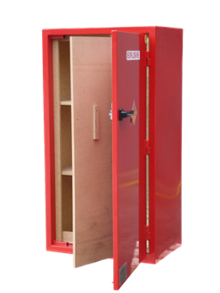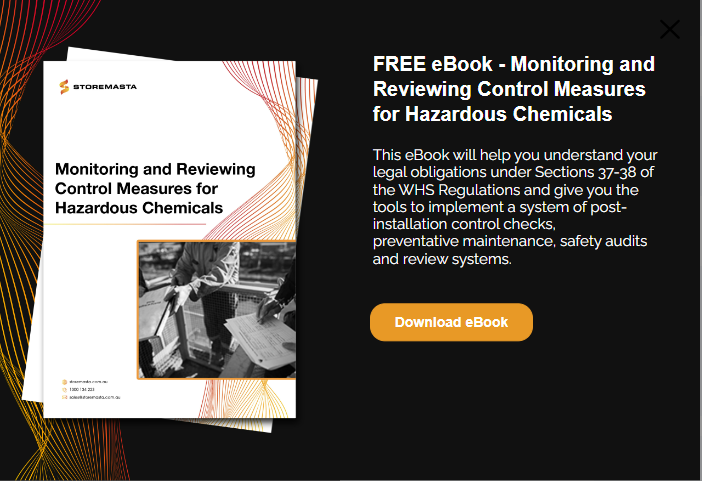As perhaps the most destructive of all classes of dangerous goods, Class 1 Explosives are a volatile group of chemical products that include black powder, fireworks, detonators and explosive devices. With the ability to decimate building sites, land mass and everything in between, staff who handle and store these materials are tasked with a serious and complex job.
When it comes to the storage of explosives within 'relocatable magazines' (such as explosives cabinets and explosive storage day boxes), there are a broad range of requirements that relate to the management of the store. The Australian Standard that pertains to explosive materials is AS 2187.1-1998 Explosives – Storage, transport and use, and we’ll be discussing some of these requirements within our post today.
What Makes A Compliant Storage Facility?
In our recent post, we highlighted the key requirements for compliant explosive storage cabinets. Regarded as portable magazines with the Australian Standard, the requirements for portable explosive magazines include:
- Constructed with steel (0.8mm minimum thickness) or aluminium sheeting (1.1mm minimum thickness)
- Lined with wood or water-resistant plywood
- Fit with a close-fitting lid (or door), which is fasted by a hasp, staple and hinges made from steel
- Feature a compliant lock
- Portable magazines must be equipped with handles
However, selecting compliant storage for your explosives is only the first step in meeting your compliance obligations. Once you have chosen and installed your explosives magazine (whether it’s portable or set in a fixed position), you’ll then have to consider the ongoing maintenance of the store.
Relocatable magazines, like this explosives storage cabinet, are constructed to reduce explosion risk.
Just like all classes of dangerous goods, explosive magazines – even portable ones – must meet general requirements for their maintenance. This may include the upkeep of the facilities, the packing of materials, cleanliness and general housekeeping of the portable magazine.
In the next section of our blog, we’ll detail the tasks that your team will need to tick off to maintain a safe, compliant storage facility.
Management of Explosive Magazines
The management of the explosive storage facilities falls under Section 4 of the Australian Standard. There are a wide range of requirements that relate to the management of explosive storage cabinets and day boxes, to ensure the safety of staff, the organisation — and the surrounding community.
Appointing Trained Staff
If staff have received the appropriate training and are at least 18 years of age, they may be tasked with the responsibility of managing an explosive magazine.
The general tasks to be performed by the designated staff will include:
- Making sure that housekeeping, maintenance, materials handling equipment, management and maintenance of records is compliant
- Withdrawing and returning of magazine keys, as well as ensuring the security of the magazine when in possession of keys
- Ensuring there is restricted access to the magazine
- Adhering to site-specific requirements
- Displaying and maintaining safety procedures within the magazine
- Maintaining copies of current legislative requirements and relevant Standards, as well as licence and conditions
Isolating Ignition Sources
If you’ve read some of our posts before, you will be aware of the dangers that ignition sources pose to workplaces that carry certain classes of dangerous goods.
Class 1 Explosives are one of the classes that must be separated from any type of ignition source. Whether explosive materials are being delivered, handled, used or stored, the isolation of workplace ignition sources is vital for the safety of people, property and the environment.

Everyday objects, such as mobile phones, can ignite explosive materials.
Ensure that all ignition sources are kept away from your explosive magazine, including (but not limited to):
- Hearing aids
- Cameras
- Mobiles
- Non-flameproof torches
- Hot surfaces
IMPORTANT: An ignition source may be any item, machinery or equipment that may produce sparks, heat, friction, impact, shock or flame. Carry out an onsite risk assessment prior to the storage of explosives at your site, to identify and isolate any potential ignition sources that may be located in your workplace — or be brought into it by workers and other personnel.
Compliant Safety Equipment
If staff are working with explosives, they require specialist dangerous goods training to ensure their safety.
When staff are fully trained and inducted to the site, they must be provided with the necessary safety equipment, so they can carry out their magazine management duties while retaining their health and safety.
Safety equipment which is permitted for use within explosive magazines may include the following:
- Fire-retarding and anti-static clothing
- Anti-static shoes
- Anti-static brooms
- Non-ferrous dustpans
- Portable fire-extinguishers of suitable capacity
The biggest risk with explosives is the risk of ignition, so static electricity, ignition sources, heat — and any articles which may spark a fire or explosion —must be strictly controlled.
REMEMBER: The cleaning, organising and general upkeep of any dangerous goods storage facility is part of your ongoing compliance obligations. We recommend implementing a regular inspection routine for your magazines, carried out by staff who are specifically appointed to the job.
Housekeeping Duties
Housekeeping duties will generally include the following:
Opening packages in a safe manner:
- Using appropriate tools to open packages
- Not opening packages of free-flowing or friction-sensitive explosives in the magazine (unless allocated for that purpose)
- Class 1 materials must be returned to original packaging or placed in suitable receptacle
- Ensuring that any prohibited items aren’t taken into the magazine (ignition sources, empty packages, rubbish, tools not related to the operation of the magazine etc.)

Knnowing how to open your explosive packages correctly is essential for safety.
Maintenance authorised by the magazine manager:
- The magazine must be kept in good working order
- Precautions must be taken when any welding, oxy cutting or similar activity (producing ignition of packages) is carried out in or on the exterior of the magazine – See Section 4.4
Cleaning of the explosive cabinet or day box:
- The magazine floor must be kept free of dirt or grit
- Spillages shall be cleaned up immediately and removed in accordance with operational procedures
REMEMBER: Tools or accessories to aid the cleaning of the magazine must be compatible with the contents of the storage cabinet or day box, to reduce the risk of an explosion. Magazine shoes or galoshes should be kept adjacent to the door of the explosive magazine.
Stacking of Packages
Just like any dangerous goods storage facility, it’s important that packages are stacked safely. If packages aren’t stored in a safe and stable way, there is a risk of the explosive packages breaking, toppling and opening accidentally.
Requirements in Section 4.6.4 of the Standard include:
- If shelving is provided within the magazine (such as an explosive storage cabinet) the stacking height may exceed 2m provided there’ no risk of damage due to compression
- If shelving isn’t provided, the height of stacked packages must be limited to prevent likelihood of damage due to compression
- The air space, between the top of stacked packages and magazine ceiling, must be at least 300mm
IMPORTANT: No other chemicals must be kept in your explosive magazine apart from the suitable Class 1 materials. Footwear, tools or implements that are essential for the keeping of explosives are allowed in limited quantities. However, they must be kept in a designated area of the magazine.
Keeping Records of Explosive Materials
Magazine operators must keep a record of all explosives that are issued, sold or transferred. Records should be kept for a minimum of 5 years.
Dangerous Incidences
From theft to thunderstorms, there are incidents that may result in the ignition of your explosive substances. The Standard outlines the measures that you must take to prevent ignition from occurring:
Fire
If a fire breaks out at your site, firefighters should follow the fire emergency plan — liasing with the magazine manager, if practicable.
The fire emergency plan should include contact details for the explosive magazine manager, location of the magazine records, type and quantity of explosives stored, a plan showing access to the explosive magazine, and the location of external fire hydrants, on-site fire installation, electrical isolation board and other dangerous goods.
-1-1.jpg?width=480&name=iStock-1198540877%20(2)-1-1.jpg)
Precautions must be taken to ensure explosive storage is not suseptible to bushfires.
In the event of a bushfire, explosives and detonators must be moved to the magazine and taken to a safe location. The explosive magazine should be closed and locked.
Personnel need to be taken to a safe place and are not to return until it’s safe to do so. The magazine manager is obliged to assist the local firefighting authority.
Thunderstorms and Dust Storms
The safety of your operations can be affected by extreme weather conditions. In the event of a thunderstorm or dust storm, you must take precautions to protect your explosive materials and the personnel at your site.
The requirements include:
- Putting explosives and detonators inside the magazine
- Closing and locking the magazine
- People must be taken to a designated safe area prior to the arrival of the storm
- No person must return to the explosive magazine unless a competent person determines that its safe
Theft
To prevent Class 1 materials from being stolen, misused or vandalised, every measure must be taken to ensure that they are not made available to unauthorized persons. Magazines must always be locked, with any theft immediately reported to authorities.
Safe Storage of Class 1 Dangerous Goods
The safest way to store your explosives and detonators is in our day boxes that are manufactured to meet Australian Standards. Investing in staff training, strict procedures and stringent maintenance and housekeeping duties will help keep your organisation protected from accidental explosions.
To find out more about the safe storage of dangerous goods, you can download our free guide. Monitoring and Reviewing Control Measures For Hazardous Chemicals will help you understand your legal obligations in relation to the maintenance and review of your controls, such as an explosive storage cabinet. Grab your copy of our guide today and keep your organisation safe and compliant.
Joining the team as a Dangerous Goods Storage Consultant, Melissa Hampton became Storemasta's Marketing Manager in late 2021. With extensive knowledge and experience in chemical compliance, Melissa is responsible for leading the Marketing team and helping shape their marketing strategy. In her spare time, you can find Melissa hiking, swimming and enjoying the great outdoors in beautiful north-west Tasmania.

